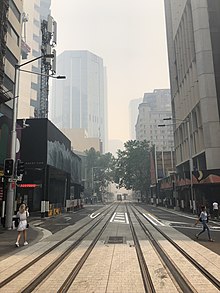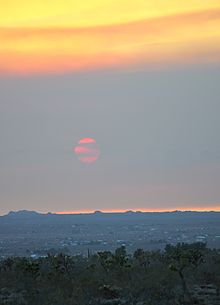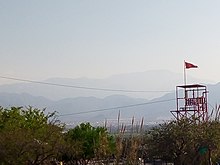
Back Waas Afrikaans عجاج Arabic Імгла Byelorussian Смуга (надвор’е) BE-X-OLD སྨུག་རྡུལ་ Tibetan Calitja Catalan Kouřmo Czech Йăсăр CV Dunst (Atmosphäre) German Ξηρά αχλύς Greek
| Part of a series on |
| Pollution |
|---|
 |





Haze is traditionally an atmospheric phenomenon in which dust, smoke, and other dry particulates suspended in air obscure visibility and the clarity of the sky. The World Meteorological Organization manual of codes includes a classification of particulates causing horizontal obscuration into categories of fog, ice fog, steam fog, mist, haze, smoke, volcanic ash, dust, sand, and snow.[1] Sources for particles that cause haze include farming (stubble burning, ploughing in dry weather), traffic, industry, windy weather, volcanic activity and wildfires. Seen from afar (e.g. an approaching airplane) and depending on the direction of view with respect to the Sun, haze may appear brownish or bluish, while mist tends to be bluish grey instead. Whereas haze often is considered a phenomenon occurring in dry air, mist formation is a phenomenon in saturated, humid air. However, haze particles may act as condensation nuclei that leads to the subsequent vapor condensation and formation of mist droplets; such forms of haze are known as "wet haze".
In meteorological literature, the word haze is generally used to denote visibility-reducing aerosols of the wet type suspended in the atmosphere. Such aerosols commonly arise from complex chemical reactions that occur as sulfur dioxide gases emitted during combustion are converted into small droplets of sulfuric acid when exposed. The reactions are enhanced in the presence of sunlight, high relative humidity, and an absence of air flow (wind). A small component of wet-haze aerosols appear to be derived from compounds released by trees when burning, such as terpenes. For all these reasons, wet haze tends to be primarily a warm-season phenomenon. Large areas of haze covering many thousands of kilometers may be produced under extensive favorable conditions each summer.
- ^ "WMO Manual on Codes" (PDF). Archived from the original (PDF) on 2018-12-22. Retrieved 2017-10-19.